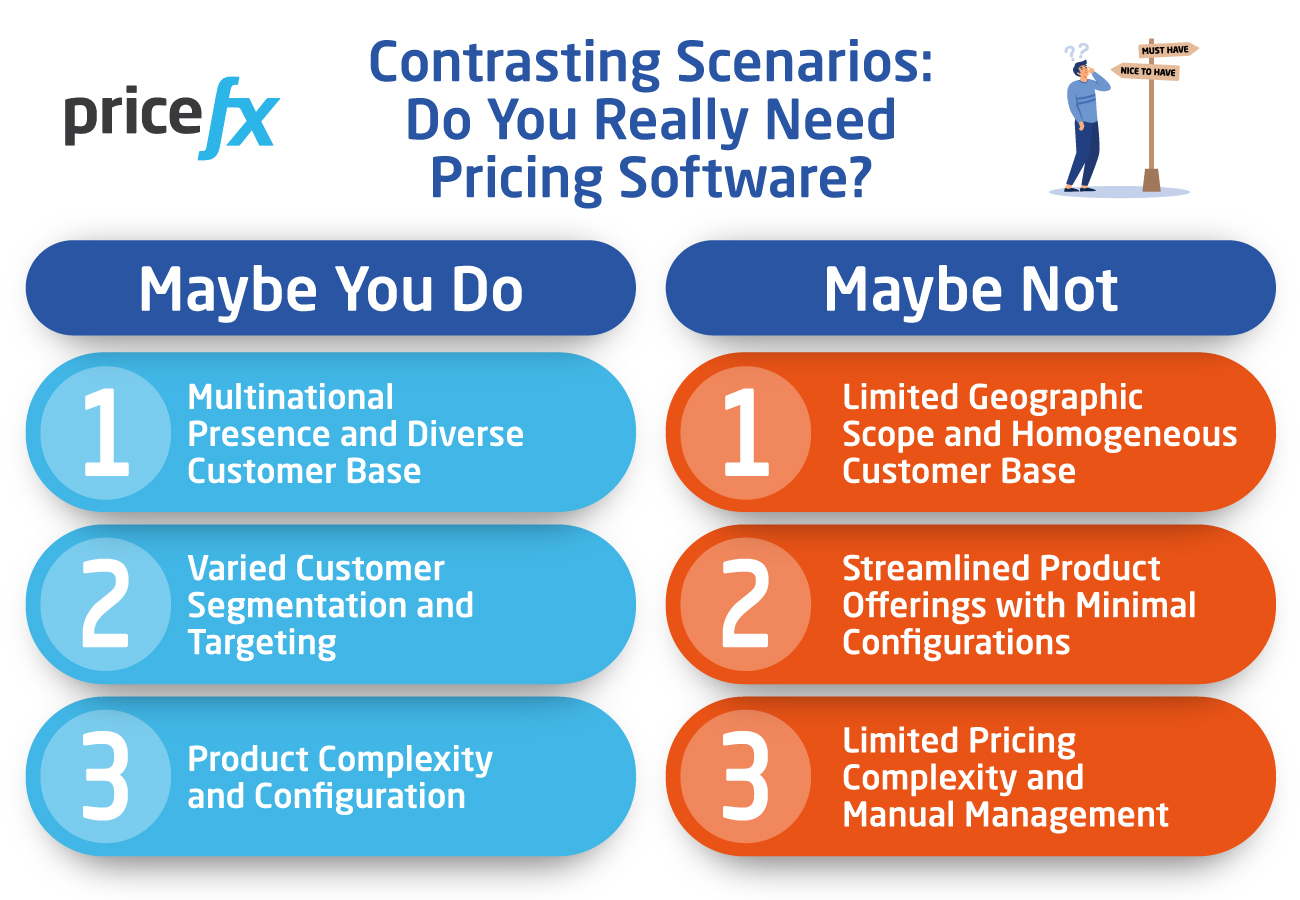Pricing Software Products: Key Necessities or Luxuries?
January 26th, 2024 | 7 min. read
The debate around whether pricing software is a fundamental business necessity, or an optional and indulgent luxury is one that tends to spark interest and deliberation among pricing industry professionals. The adoption of pricing software products and tools has become a pivotal discussion, particularly for enterprise-level companies operating across diverse regions, serving various customer types and segments, and managing products with multiple configurations. Consequently, it is imperative to explore this debate through the lens of organizational structure and business practices to ascertain the relevance and significance of pricing software in different scenarios.
With its suite of innovative AI-informed pricing tools and analytics, Pricefx offers businesses the promise of pricing excellence. But does one size fit all? Does every business really require power of Pricefx and make the most of the award-winning pricing solutions that Pricefx has to offer? Most might, but does every business need a high-tech pricing software solution? Maybe not.
In this article, we will explore some factors to consider (your company’s organizational landscape, its product complexity and configuration variations, and the types of customers you work with and where they are based) when determining if your company needs pricing software.
Understanding the Varied Organizational Landscapes
Multinational Presence and Diverse Customer Base
For companies with a global footprint or with diverse and widespread markets, navigating multiple countries or regions entails grappling with distinct market conditions, regulatory landscapes, and varying customer preferences. In such expansive business environments, pricing software emerges as a strategic asset.
Pricing software engineered to handle the intricate nuances of vast product catalogs with myriad attributes, configurations and calculations.
Large enterprises, by nature, contend with the need for diverse and intricate pricing structures. They manage product portfolios that may span thousands of items, encompassing multiple variations.
Moreover, the geographical reach of these corporations adds another layer of complexity, as pricing strategies often varies by region due to market dynamics and local competitive forces with a multitude of different customer types, each requiring their careful pricing considerations.
Pricing software can empower enterprise businesses by automating and streamlining the pricing process, thereby enhancing operational efficiency, and ensuring accurate, data-driven pricing decisions. Its sophisticated algorithms and analytics capabilities enable companies to adapt swiftly to changing market conditions, capitalize on profitable opportunities, and maintain competitiveness on a global scale.
Consider a manufacturing giant with tens of thousands of products with markets across Europe, Asia, and the Americas. Each market presents unique challenges, including fluctuating currencies, diverse consumer behaviors, and localized competitive landscapes.
In this scenario, pricing software becomes critical in analyzing regional market trends, optimizing prices across borders, ensuring price compliancy, enabling competitive positioning, plus diversifying and localizing company pricing strategies tailored to specific demographics.
Enterprise businesses are usually global giants, operating in multiple countries and regions. The global scalability of pricing software ensures that pricing strategies can be seamlessly applied across international markets, accounting for currency fluctuations, local competition and regulatory intricacies. This international reach and scalability for pricing software is indispensable for enterprise businesses.
What’s more, pricing software makes positive impacts on operative pricing and pricing governance for large-scale enterprise businesses. With the automation of pricing software, huge manual operative pricing efforts are reduced. Price Governance transforms to smoother operational standards as automated rules for workflows and ensures compliance instead of countless emails and chats.
And of course, with pricing software, almost real-time and flexible reactions to macroeconomic events facilitate a level of dynamic pricing never possible previously without the technology.
Varied Customer Segmentation and Targeting
Segmenting customers based on preferences, buying behavior, market access or demographics is a strategic approach adopted by many businesses. For instance, a distributor catering to both retail and wholesale customers may require distinct pricing strategies tailored to these separate segments. Pricing software empowers businesses to implement granular pricing strategies, offering specific discounts or incentives to various customer segments. This personalized approach enhances customer satisfaction, fosters loyalty, and optimizes revenue streams.
Learn more here about customer segmentation and why specifically it is crucial to good pricing outcomes in the distribution industry sector specifically for example:
Product Complexity and Configuration
Both manufacturers or distributors may deal with products featuring multiple configurations or customizable options face intricate pricing challenges. Take, for instance, a company offering specialized machinery with varying specifications and optional add-ons. To extend that analogy one step further, now imagine the manufacturing company is building jet airliners. Jet engines alone may comprise more than 40000 parts, whilst an entire aircraft could comprise millions of parts.

Consequently, calculating accurate pricing for these types of products (or spare parts for them – wow, imagine that!) manually can be arduous and prone to errors. Here, pricing software streamlines the process by facilitating dynamic pricing models, managing complex pricing structures, and automating configuration-based pricing adjustments. It not only enhances operational efficiency but also ensures precise pricing consistency across diverse product variations.
Contrasting Scenarios: Do You Really Need Pricing Software? – Maybe Not
Scenario 1: Limited Geographic Scope and Homogeneous Customer Base
In contrast to multinational enterprises, smaller businesses operating within a confined geographic area with a relatively homogeneous customer base may find pricing software less critical. For example, a local artisanal bakery serving a consistent customer demographic in a single city might not encounter the complexities necessitating sophisticated pricing software. In such cases, simpler pricing methodologies or traditional approaches may suffice, considering the manageable scale and uniform market conditions.
Scenario 2: Streamlined Product Offerings With Minimal Configurations
Some businesses thrive on simplicity in their product offerings, avoiding complex configurations or customization options. For instance, a company manufacturing standardized, off-the-shelf consumer electronics may not confront the intricacies of customizations and variations. In these scenarios, where product variability is minimal, the need for specialized pricing software may not be as pronounced. Straightforward pricing structures can be efficiently managed without the complexity that necessitates software intervention.
However, a word of caution for this approach. Take a tire manufacturer for example. Yes, it is true – they are only producing tires. But for them, maybe the aspect of low configuration must be combined with a homogenous distribution channel and /or no need for pricing changes and scalability of their calculations, or they are producing only for customers with long-term agreements in place.
Scenario 3: Limited Pricing Complexity and Manual Management
Certain businesses, despite operating across diverse regions or serving various customer segments, may manage pricing complexities effectively through manual interventions or traditional methods. For instance, a small-scale distributor dealing with a limited product range might find that the volume of transactions and pricing variations is manageable without the need for sophisticated software tools.
However, as the business expands or diversifies, the scalability and accuracy of manual approaches might become increasingly challenging.
The Bottom Line: Tailoring Solutions to Organizational Needs
Ultimately, the necessity or luxury status of pricing software hinges on an organization’s unique structure, operational landscape, and the complexities inherent in its business model. The decision to adopt pricing software like the scalable Pricefx solution that can grow with your business as you do, should be a thoughtful one, considering factors such as:
- Geographic Reach: Extent of operations across diverse regions.
- Product Complexity: Variation and customization within product offerings.
- Customer Segmentation: Varied customer types and the need for tailored strategies.
- Commercial Conditions Complexity: Varied and complex agreements for to incentive revenue goal realization.
While pricing software undoubtedly offers strategic advantages in managing complexities and optimizing profit and revenue, its relevance in a particular context depends on the scale, scope, and inherent intricacies of the business.
To dive deeper into the subject of small vs large enterprise businesses and what might be the best pricing solution for your company, please check out the article below to learn more:
Meanwhile, Happy Pricing!



